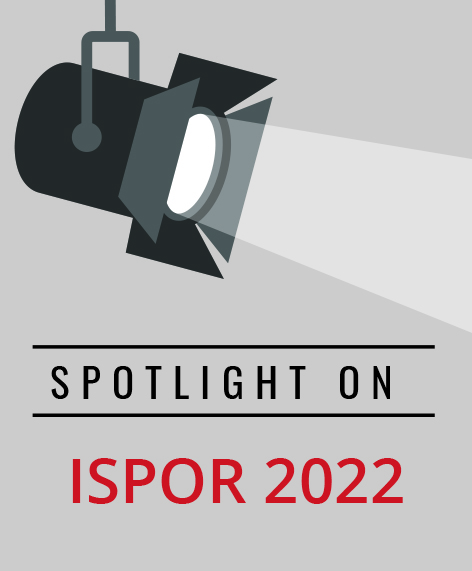Capturing Humanistic Outcomes: A Vital Part of Therapeutic Management
Mark Bounthavong, PharmD, PhD, UCSD Skaggs School of Pharmacy & Pharmaceutical Sciences, La Jolla, CA, USA; Enrique M Saldarriaga, MS, The Comparative Health Outcomes, Policy, and Economics (CHOICE) Institute, University of Washington, Seattle, WA, USA
Quality of life, health utilities, and patient-centered measures comprise the humanistic element of the Economics, Clinical, and Humanistic Outcomes (ECHO) model.1 This continues to remain a keystone for the overall assessment of therapeutic intervention. Capturing patient-reported outcomes requires the identification of essential domains of the measurement, development, and validation of instruments. The 4 presentations in this session moderated by Meng Li, PhD, MS (University of Texas MD Anderson Cancer Center, USA) provided exemplary applications of the tools and methods used to ensure that the values and instruments that are captured and applied, are accurate, valid, and reliable.
“As treatment becomes more complex and expensive, another toxic reaction has to be dealt with: financial toxicity.” – Mukhtar Ahmad Dar, PhD, MPharm
Shauna McManus, MPH (OPEN Health Evidence & Access, USA) discussed the work her team has done to apply anchor-based approaches for estimating thresholds for meaningful within-patient change (MWPC) for legacy instruments such as the European Organization for Research and Treatment of Cancer Quality of Life Questionnaires, EORTC QLQ-C30 and EORTC QLQ-LC13. Leveraging data from a randomized control study, McManus and colleagues measured the change in MWPC thresholds from baseline for the following domains: cough, pain in arm or shoulder, pain in chest, and pain. QLQ-C30 Global Health/QoL status domain functioned as a global anchor. According to the US Food and Drug Administration (FDA), MWPC should be an average change in the EORTC scores of at least 33.3 points. However, McManus and colleagues reported that clinically relevant patient-reported outcomes score had a MWPC threshold that is approximately 16.7 points, which is a change of 1 category on the raw score. Moreover, McManus concluded that regardless of whichever of the thresholds were used there was clear separation of the treatment arms, supporting the use of both a lower MWPC threshold identified in their study and the FDA recommendation.
Mukhtar Ahmad Dar, PhD, MPharm (National Institute of Pharmaceutical Education and Research [NIPER], India) and colleagues developed the Subjective Financial Distress Questionnaire (SFDQ) to identify radiation oncology patients who are at risk for financial toxicity. Dar remarked that, “As treatment becomes more complex and expensive, another toxic reaction has to be dealt with: financial toxicity.” The initial tool contained 17 items and was administered to patients with head and neck cancer (N = 142), but this was reduced to 14 items after initial exploratory factor analyses. In the confirmatory factor analysis, the model fit suggested that the SFDQ fit well into 3 factors (financial and psychosocial affect, coping behavior, and support seeking). Further, excellent reliability was verified based on a Cronbach’s alpha of 0.87. By identifying patients who are at risk for financial toxicity using the SFDQ, decision makers may reduce the financial burden and distress and improve overall outcomes associated with oncology treatments.
Paul Swinburn (Evidera, UK) and colleagues performed a study to capture the health state utility values among nonmuscle invasive bladder cancer (NMIBC) patients at different stages of bladder cancer. Of concern is radical cystectomy, which is an invasion treatment strategy used for patients who are unresponsive to NMIBC initial treatments. In phase I, Swinburn and colleagues performed a time-trade-off (TTO) exercise to identify health states among NMIBC patients. In phase II, utility elicitation was performed by administering the TTO to the healthy general population (N = 202) in London, United Kingdom across different NMIBC scenarios in order of preference. According to Swinburn, “Health states were either ‘chronic’ (valued in the TTO task with a 10-year time horizon) or ‘path’ (1-year time horizon).” Average utility scores were 0.781 for “no high-grade recurrence”, 0.586 for “high-grade recurrence”, 0.572 for “>1-year post cystectomy”, and 0.283 for “NMIBC with metastatic disease.” Respondents preferred to delay radical cystectomy as a treatment alternative for bladder cancer supporting patient’s preference for bladder-sparing therapy.
Rachael Pattinson, MSc (Cardiff University, UK) and colleagues conducted a study to develop a framework that would be used to identify impact items for the development of a patient-reported outcome instrument, Patient-Reported Impact of Dermatological Diseases (PRIDD), to capture the impact of dermatologic diseases on patients’ quality of life. A 2-round modified Delphi study was performed on 1154 respondents globally, using a combination of quantitative and qualitative data followed by a framework analysis. A total of 27 items across 5 domains (physical, psychological, social, financial, and daily life) were identified as a first draft of the PRIDD, which is undergoing psychometric testing. The PRIDD would be able to identify meaningful issues that impact patients with dermatologic conditions, which may be informative for decision makers when they develop treatment strategies.
"Respondents preferred to delay radical cystectomy as a treatment alternative for bladder cancer supporting patient’s preference for bladder-sparing therapy."
Accuracy and validity in measuring patient perceptions remains a critical and important part of the overall healthcare patients receive. These presentations highlight the various areas of need and demonstrate the creativity and application of current and innovative tools that are used across a variety of diseases.
References
1. Kozma CM, Reeder CE, Schulz RM. Economic, clinical, and humanistic outcomes: a planning model for pharmacoeconomic research. Clin Ther. 1993;15(6):1121-1132; discussion 1120.

